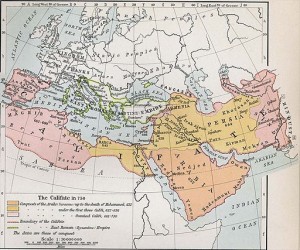Considering the current state of play, scenario 3: A Real Victory in Syria, and its sub-scenarios are rather unlikely in the short-term. However, they are worth outlining because they bring analytical insight into dynamics and potential strategies to favour or counter one or the other possibility, according to interests, and because they could be relevant for the medium term. The chaos and beginning of “warlordism” that characterizes the Syrian situation, as emphasised by analysts, (e.g. Joshua Landis, 1 May 2013, Syria Comment; Aymenn Jawad Al-Tamimi, 14 May 2013, Jihadology; see also first post of the series on Syria) lead to the relatively small probability to see any of those scenarios (or rather variations on them) happening. Nonetheless, as for scenario 1: Peace in Geneva and scenario 2: No Syrian in Geneva, and besides signals indicating an improvement in the ambient disorder, we shall attempt to outline indicators that could be more specifically monitored for assessment of likelihood and timeline.
Scenario 3: A Real Victory in Syria?*
Once the victory of one of the belligerents over all others happens, then the victor is in a strong domestic position, and may start reconstructing a true peace.
The first years would still be difficult and the new government would have to develop novel ways to stabilize the situation, making sure the vanquished would not find a way back towards violence and war. The state administration would have to be reconstructed where it has been destroyed so that the mission of political authorities may be carried upon successfully. Yet, we are in a political configuration that is much easier than what we had in scenario 1. Indeed, war cannot truly be won on a given territory without fighting troops that are sufficiently united to enable proper strategy, operations and tactics, and without a population that is mobilized and/or controlled (the “support” given by the people can be achieved with more or less coercion, but needs to be there – see notably the literature on counter-insurgency, and also theories – and practice – of People’s war). Thus, achieving victory means that the victor has also succeeded in having an efficient monopoly of the means of violence (the winning fighting troops and the coercive apparatus within the population, ranging from mild to violent), as well as a way to extract surplus from the population in exchange for services (including waging the war).
As a result, winning the war implies that the fundamental processes underlying functioning political authorities have been implemented and mastered. The change from war and emergency to peace must still be achieved, while the new political authorities must consolidate their legitimacy, and those are crucial challenges, hence the difficult first years, but the foundations for succeeding are there.
How the stabilization from war to peace would be done, with which type of political authorities, and under which kind of regime, would vary with the victorious belligerent. The international impact would change accordingly, with, in turn, consequences on the Syrian domestic situation and the type of peace the victor would succeed in implementing.
Scenario 3.1.: An Islamic al-Sham?
If the victorious groups were Salafi-Jihadi, they would create a theocracy, a strict Sharia state. If we refer to Jabhat al-Nusra’s April declaration (Barber, 14 April 2013, Syria Comment), then they would seek to create the Islamic State of Al-Sham, i.e. a political entity covering the Levant. If we refer to Abu Bakr al-Baghdadi, the leader of Al-Qa’ida in Iraq, then their objective would be to create the Islamic State of Iraq and Al-Sham (ISIS) (Ibid). As explained by Aymenn Jawad Al-Tamimi (14 May 2013) and by Lund (22 May 2013, Syria Comment), who also reviews other related analyses, we are currently under a thick fog of war as to what is happening within the Al-Qa’ida factions in Syria: we do not know exactly if there is strife between various groups, how important it is, and which side, if any, will win.
Whatever the reality that will emerge, and for the sake of this scenario, thus assuming that the victorious groups are Salafi-jihadi, the current territorial Syria (with or without the Syrian Kurdistan, according to the way the war would be waged on that part of the territory and won or lost there) would most probably be seen as the heart from which the war to conquer the rest of the Levant (with or without Iraq according to case) could be waged. The new Al Sham would thus be expansionist and carrying the Salafi-Jihadi aim that “seek[s] to establish an islamic caliphate that would encompass the entire Umma, or Muslim community” (O’Bagy, September 2012:17) through all means, from overt war to supporting terrorist networks and individual jihad abroad.
The caliphate or Khilafa is explained in and defined with different terms according to authors, yet similarities remain, notably expansion:
“The most famous exposition of the Islamic theory of State was by the scholar al-Mawardi, who claimed that the establishment of the Caliphate was an Islamic obligation agreed upon by the scholars. His treatise al-Ahkam al-Sultaniyya (the rules of governance) remains one of the major classical references for Islamic political theory. In it, he explains that the ruler is either elected by the peoples’ representatives or through being nominated by the previous Caliph. The Caliph’s responsibilities include implementing the hudood (punishments explicitly proscribed in Islam for acts such as theft, rebellion, public acts of extra-marital intercourse), collecting and distributing the taxes according to the Sharia prescriptions, and to protect and expand the borders of the Islamic State.” Dr. Reza Pankhurst, political scientist and historian, specializing in the Middle East and Islamic movements, “Understanding Calls to a Caliphate,” 22 August 2011, Foreign Policy Journal.
“Khilafa (caliphate) for Islamists is the idea that they are duty bound to establish “Islamic states” – described by vague, theoretical, idealistic platitudes – that would then be united in a global, pan-Islamic state or ‘new caliphate’.” Quilliam Foundation researcher Dr Usama Hasan for BBC News, 24 May 2013
“Both historically and doctrinally, the caliphate’s function is to wage jihad, whenever and wherever possible, to bring the infidel world under Islamic dominion and enforce sharia. In fact, most of what is today called the “Muslim world”—from Morocco to Pakistan—was conquered, bit by bit, by a caliphate that began in Arabia in 632.
A jihad-waging, sharia-enforcing caliphate represents a permanent, existentialist enemy—not a temporal foe that can be bought or pacified through diplomacy or concessions. Such a caliphate is precisely what Islamists around the world are feverishly seeking to establish.” Raymond Ibrahim, associate director of the Middle East Forum, 8 March 2011, Gatestone Institute.
Despite the necessity for expansion, aggressive actions might also be delayed, or slowed, to allow first for consolidation at home.
However, if the rivalry between Salafi-Jihadi groups were to re-appear after a victory on the Syrian territory, then the chance for consolidating peace at home would be reduced because of internecine struggle, following, in essence on those that would be taking place currently. In the meantime, the potential for aggressive jihadi actions would be enhanced, as all groups would want to assert their Jihadi credentials and use them to ideologically motivate fighters, while probably also alienating part of the population, which would again contribute to lower the odds to fully stabilize the situation domestically.
The states directly threatened by an aggressive Al-Sham – and other similar regional entities – would have no other choice than to retaliate. The prospects for a regional and global conflagration would be heightened. Peace in Syria would have been short.
Estimating Likelihood for Scenario 3.1.
To date, the likelihood to see this scenario happening is summarized by Aymenn Jawad Al-Tamimi (14 May 2013): “In the midst of such chaos, I see it as unlikely that JAN [Jabhat al-Nusra] will either substantially advance its position or lose ground beyond likely strongholds in the north and east. While JAN may routinely be described as the most effective fighting force, it can be too easy to overstate the group’s actual size and influence. To sum up, I see an equilibrium of disorder developing. »
Using Aymenn Jawad Al-Tamimi’s article as well as Lund’s (22 May 2013), we can come up with a few indicators that should be followed, besides following the course of the war in Syria:
- The state of tension, from disagreement to split within Al-Qa’ida groups operating in Syria and between all Salafi-Jihadi factions.
- The evolution of the situation in Iraq, notably of Al-Qa’ida.
- The degree of acceptance of strict sharia law within the Syrian population, as well as within the larger regional and global Sunni population.
- The existence of viable alternatives, both materially and spiritually, for the population, including the persistence of hope: if no other models are provided besides an Islamic state of Al Sham and a caliphate, if people are desperate, then they may well find progressively new meaning and survival in a Islamic Al Sham (read on this the beginning of Reza Pankhurst’s article (22 August 2011).
- The capability of the Salafi-Jihadi groups first as belligerents then as winning rulers for sustained domestic control and coercion, on the one hand, for co-optation and persuasion on the other.
Scenario 3.2….
———-
* Besides a real victory for one of the belligerents, Edward Luttwak, in his article “Give war a chance,” (Foreign Affairs; Jul/Aug 1999; 78, 4) sees a second possibility that could lead to a true peace: the exhaustion of all belligerents. I shall not here take into account this hypothesis because in a short to medium term future, it seems to be even less likely to happen than scenario 3, considering the multiple existing external involvements.
Detailed bibliography and primary sources forthcoming.


![[Victory]...depends on overwhelming striking force, 1939-1946, by S Whitear, The National Archives (United Kingdom), catalogued under document record INF3/138, Public domain, via Wikimedia Commons victory, striking force, war scenario](http://www.redanalysis.org/wp-content/uploads/2013/05/INF3-139_War_Effort_Victory_depends_on_an_overwhelming_striking_force_Artist_S_Whitear.jpg)


